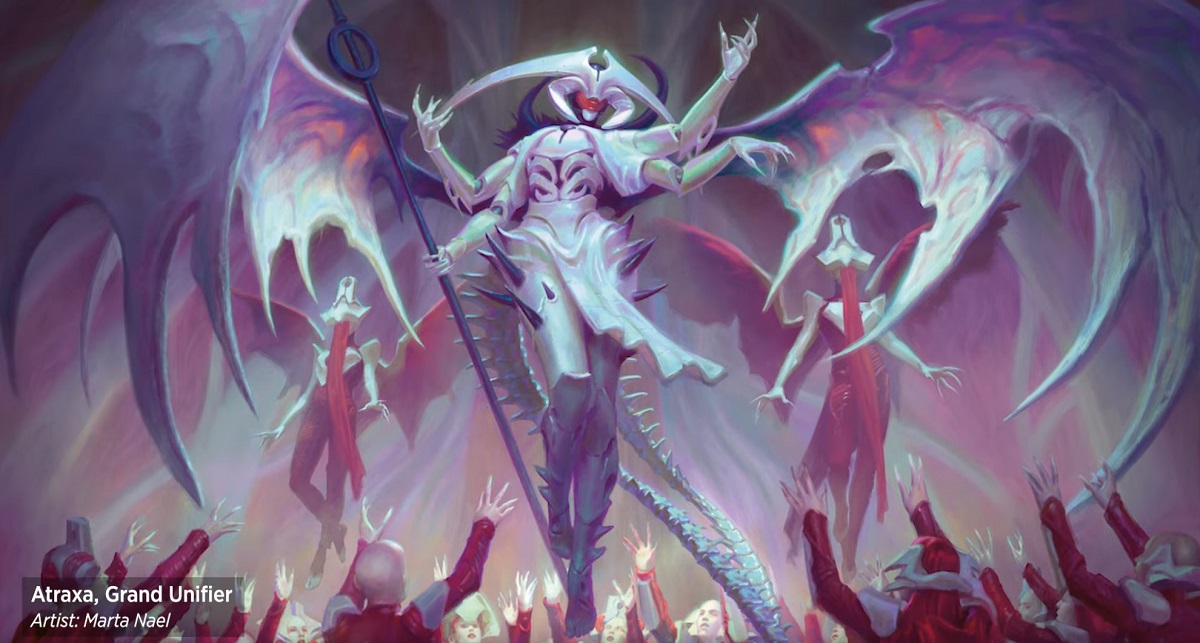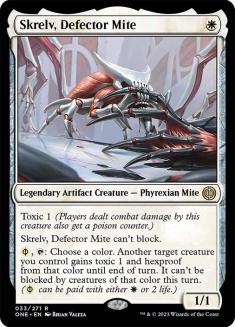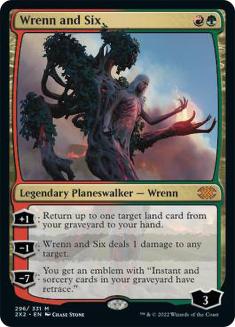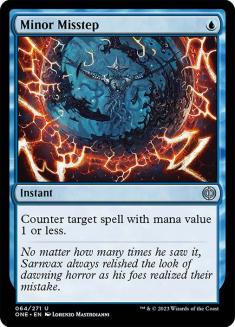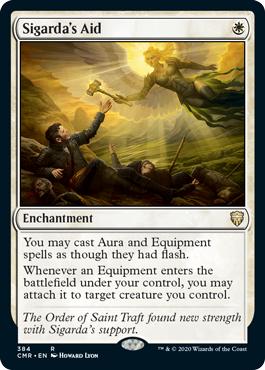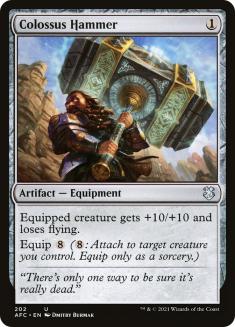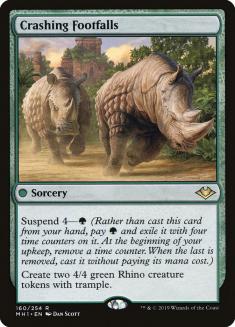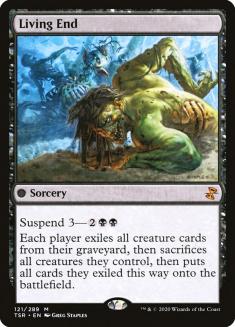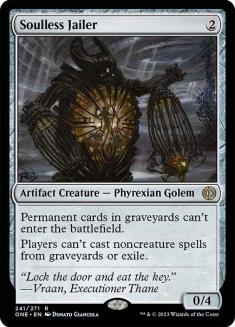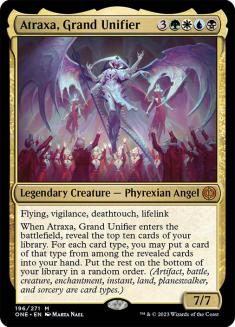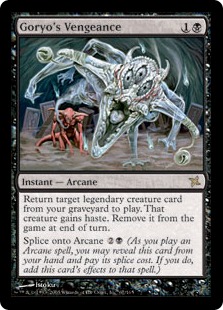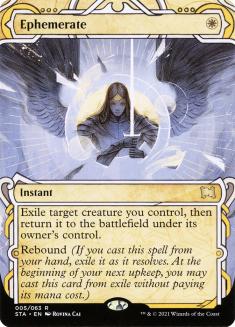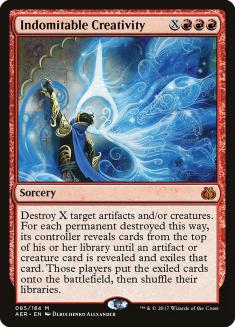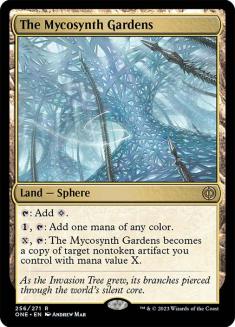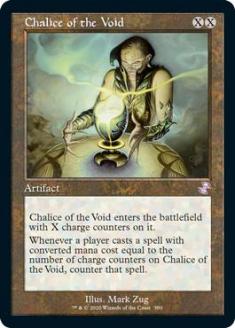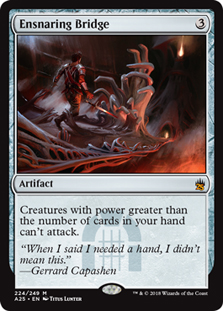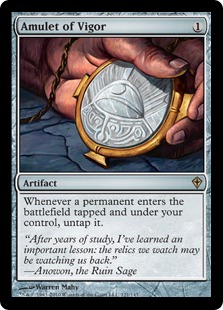It’s all Phyrexia, all the time for the next few months in Magic. The Phyrexians are adept at taking over new worlds in horrifying fashion – can they conquer Modern, too? I raised the hopes of Devoted Druid fanatics last week, but that’s just the start.
Skrelv, Defector Mite
Skrelv does a welcome imitation of Giver of Runes in smaller formats, but has to compete with it in Modern. I expect the more generic creature decks that play Giver will stick with it, but Skrelv has some unique advantages in the most common Giver deck, Mono-White Hammer. As an artifact, it grows your Constructs from Urza’s Saga, helps with metalcraft for Puresteel Paladin, and can be buffed by Blacksmith’s Skill.
Its odd wording is subtly important as well. Giver of Runes was sometimes awkward against instant-speed white removal like Solitude and Leyline Binding – if these tried to remove a creature in response to the trigger from Sigarda’s Aid, giving it protection from white would fizzle that trigger too, defeating the point. Skrelv’s “hexproof from…” implementation gets around this. In return, you lose Giver’s ability to grant protection from colorless, which can matter in Construct fights or against the Neon Dynasty channel lands.
The best argument against Skrelv is the same one that’s fatal for so many promising one-toughness creatures: when Wrenn and Six was everywhere in Legacy,
Giver of Runes saw play over Mother of Runes solely because of that second point of toughness. Wrenn and Six isn’t quite so popular in Modern and has fallen from its Yorion-era peak, but is still one of the best threats in the format, and losing your one-drop and primary form of protection to it can be devastating.
Minor Misstep
This callback to New Phyrexia’s most notorious design might be the most polarizing card in the set. You can find people hailing it as the second coming of Mental Misstep and others calling it unplayable right next to each other just a short Twitter scroll away.
My verdict is cautiously optimistic. One-mana interaction is a necessity in a format as fast as Modern, but all the current options have their own holes. Spell Snare is seeing a minor resurgence mostly thanks to Wrenn and Six and the trio of Ledger Shredder, Expressive Iteration, and Counterspell in the Izzet decks but is very poor otherwise. Spell Pierce is a common use of those flex slots in Izzet and is one of the best cards in and against the Indomitable Creativity decks, but even against its intended targets it can quickly become dead. You can snag a Sigarda’s Aid on Turn 1 but not the Colossus Hammer that pairs with it on Turn 4.
Minor Misstep is the best one-mana counterspell against the two mainstays of the format since Modern Horizons 2 – Hammer and Izzet. It’s a fine trade for Esper Sentinel or Giver of Runes on the first turn and you’ll gladly use it on Sigarda’s Aid or Colossus Hammer at any point. Against red decks of every stripe, Misstep keeps up with both the creatures – from Ragavan, Nimble Pilferer and Dragon’s Rage Channeler to Goblin Guide or Soul-Scar Mage – and the Unholy Heats or Lightning Bolts that back them up. It’s hard to imagine a better reactive card at this cost against Burn, for example.
Unlike these other cards, Minor Misstep can never trade up on mana – but in the matchups where the one-drops are what scare you most, that doesn’t look like a downside. The problem there is that these one-drops are much scarier on the play and you need the answers to them even more on the draw before Misstep is online. Misstep doesn’t address the fact that Ragavan is much harder to handle on the draw – it makes that problem worse, since Izzet can defend the Monkey with their own Missteps!
A more certain application is as an anti-Cascade measure for blue decks. Here, Misstep only competes with Flusterstorm and Invasive Surgery, which have their own pros and cons – Surgery is appealing if Creativity is too – but Misstep’s broad coverage elsewhere should give it the nod.
Soulless Jailer
Soulless Jailer joins the roster of colourless hate cards, giving every deck a wider range of sideboard tools. Drannith Magistrate is often seen in Mono-White Hammer sideboards, and this opens that option up for other decks – perhaps even Hammer itself, since Jailer being an artifact has the benefits mentioned for Skrelv above.
Atraxa, Grand Unifier
In a card pool that spans twenty years, there’s a depressing lack of big bad monsters to cheat onto the battlefield – Modern Horizons 2 gave us Persist but had to offer up Archon of Cruelty for it to have any worthwhile targets. Goryo’s Vengeance has always been one of the most potentially dangerous cards in Modern, but that potential was never fully realized, in part because of a lack of targets. A hasty Griselbrand is powerful but requires a big commitment, while Emrakul, the Aeons Torn was sent into an early retirement by Solitude and Leyline Binding.
Atraxa, Grand Unifier makes that list longer and stronger. An offshoot of Esper Reanimator that stole my heart recently used the Grief / Solitude + Ephemerate package to immediately convert a fresh hand from Griselbrand into something meaningful or blink Griselbrand to rescue it from being exiled by Goryo’s Vengeance. One problem was that there was simply no good backup legend to reanimate – you could borrow Obzedat, Ghost Council from old-school Esper Goryo’s Vengeance, but that only worked at all then because the removal was much worse. Atraxa does everything I want – it sets up those Evoke + Ephemerate lines in the same way (and even refills your hand if blinked itself) and pitches to those Evoke Elementals too.
I could also see Atraxa as a primary or secondary Indomitable Creativity hit in matchups where a single Archon of Cruelty is easily dealt with, powered through, or hijacked by a sideboarded Orvar, the All-Form. Even though you have to support a Dwarven Mine manabase and a triple-red signature spell, you should have the right colours for Atraxa once you get to seven mana, and seven is much easier than eight – casting this feels a lot more realistic.
The Mycosynth Gardens
The Mycosynth Gardens is the new card I’m most excited about personally, even though it doesn’t fit cleanly into the existing artifact-centric decks. Hammer already has enough issues with colored mana that it often shaves an Inkmoth Nexus, and copying a Colossus Hammer won’t help if your enabler is Sigarda’s Aid. Similarly, my beloved Hardened Scales has more colorless lands than it knows what to do with, and copying the basic stats of a modular creature or Walking Ballista doesn’t work the way you want it to!
The nontoken clause on The Mycosynth Gardens also prevents the natural use of making yet another Construct token at a low cost. If the final chapter of Urza’s Saga spits out something worth copying, that’s some small consolation.
That said, I have a few homes in mind:
The ‘Prison Tron’ deck that uses cards like Chalice of the Void and Ensnaring Bridge to lock down the game will have a keen interest in this card. Gardens won’t copy any charge counters on your Chalice, but you want to copy it most in a matchup where it won’t have any at all. Chalice of the Void is the bane of the Cascade combo decks, but its one weakness is that you can only have one – a resolved Chalice for zero will the next one you cast. This lets a well-timed bounce or removal spell on your Chalice unlock their cascade spells for just long enough. Gardens gets around that by turning itself into a ‘free’ backup Chalice on demand, killing off a Living End for good.
Ensnaring Bridge isn’t what it used to be, but it’s still the centerpiece of this strategy as a way to shut off the main route to victory for many decks. In a world of Boseiju, Who Endures and Otawara, Soaring City, most attackers will have a smattering of answers to the first Bridge, but the second is lights out – Gardens can become a second copy, either quickly or in response to the eventual answer to the first.
Between an entirely colorless manabase with room for utility lands and Expedition Map to find them, it’s much easier to fit some Gardens here than elsewhere.
And then there’s Amulet. Amulet Titan has cycled through periods of dominance and then decline for years, but this card is a possible game-changer. Despite Amulet running over thirty lands, there’s still nowhere near enough room for all the lands you want to play – even so, the ceiling on this new land is high enough that it might prompt a total restructuring of the manabase to fit it.
This isn’t immediately obvious. Inexperienced Amulet pilots often place too much emphasis on games where you have Amulet when evaluating new cards, rather than focusing on the games where you lack your namesake and need more help. The Mycosynth Gardens looks like yet another example of that – it only does something special when you have an Amulet, and all that thing amounts to is making another Amulet.
That second Amulet is big, though. With two Amulets, it’s trivial to jump up to six mana for a Primeval Titan that is immediately lethal unless you face resistance and gives you the resources to fight through that resistance. Lines that involve chaining Cultivator Colossus or routing mana through Tolaria West for Summoner’s Pact for Colossus or Titan are much more feasible. The Mycosynth Gardens doesn’t add a new angle to the deck, but it makes your main plan faster and more consistent overall.
This is a modest haul for Modern compared to some sets and there aren’t any obvious, permanent fixtures of the format here, but there’s enough that sparks joy for me personally that I, for one, welcome our new Phyrexian overlords.

